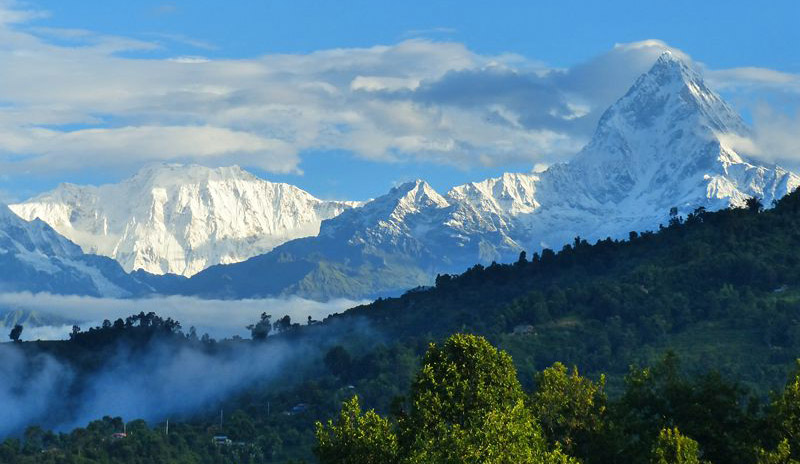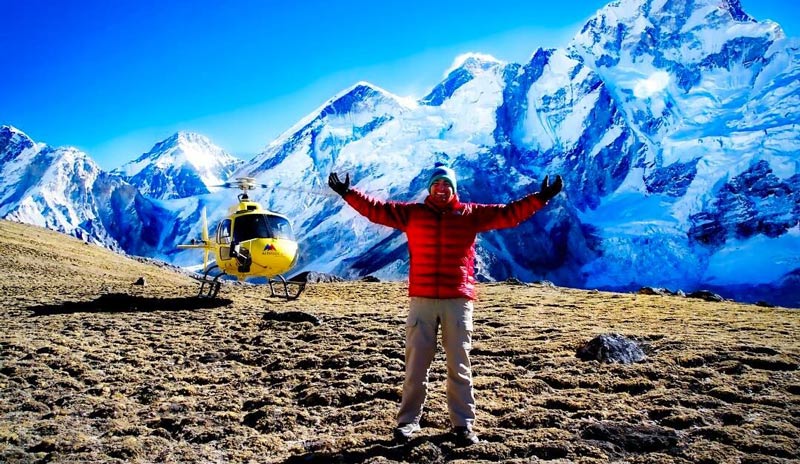8 Amazing Things About Nepal That May Surprise You
Situated in the south of the Himalayas, Nepal is a country full of diverse ethnic groups, various festivals, breathtaking scenery and rich culture. Most of Nepali traditions are mysteries for foreign tourists. Here are some interesting things that must surprise you.
 Boudha Stupa
Boudha Stupa
1. Dogs' Big Day
Every dog has its day, but for dogs in Nepal, they will get more on the"Kukur Puja" or "the Day of Dogs", the second day of the five-day Nepalese Hindu festival of Tihar. In ancient sacred texts, dogs are described as loyal companions, helpers and guardians of humans. Moreover, the locals believe that the dog is the messenger of the god Yamaraj, and will escort the soul of the deceased. Dedicating the day to dogs is seen as pleasing the god.
To thank for their friendship and loyalty on this special day, both pet dogs and stray dogs are given beautiful wreaths and marigold petals. Their foreheads are also marked with a "tika" made from red-colored powder, rice and yogurt, as a sign of sacredness and a blessing to those who encounter the dogs. A liturgical ceremony is also held, which is generally attended by police dogs in recognition of their contribution to human security. Maybe dogs' favorite part of the celebration is to feast on various goodies ranging from fruit and cookies to eggs, milk, meat, even hand-made desserts. If you are a dog lover, you must go to see and experience for yourself this special tradition in Nepal.
2. Skydiving from Mount Everest
Nepal is known as the famous ultimate outdoor-sports destination, offering a wide range of sports like rock climbing, canyoning, ziplining etc. The most challenging sport may be skydiving from Mount Everest and land in the highest zone in the world.
 A view of the Himalayas
A view of the Himalayas
Mount Everest, rising 8848 meters above sea level, the main peak of the Himalayas, is the highest mountain and parachute location in the world. Those extreme sports enthusiasts from all over the world take off from the near airport and then drop off to enjoy a panorama of awe-inspiring Mount Everest and feel a surge of adrenaline in the body. Absolutely, this will be the most thrilling air adventure of your life.
 Enjoy a bird's-eye view of Mount Everest through a helicopter
Enjoy a bird's-eye view of Mount Everest through a helicopter
Paragliding in Pokhara
For novices who want to experience skydiving but don't want to take too many risks, you can try paragliding with a lower price in Pokhara, one of the top three paragliding destinations in the world. When you paraglide through the valley of Pokahara, you can also overlook the majestic Himalayas, beautiful lakes, villages, temples and forests.
 Paragliding through the valley of Pokahara
Paragliding through the valley of Pokahara
Tips for skydiving and paragliding:
a. Only suitable for healthy adults without overweight, high blood pressure and cardiovascular diseases.
b. The best time is November, staying one more day in case of bad weather.
c. Best to wear loose clothing and sneakers.
3. Drinking Fresh Blood of Yak
Although Nepali cuisine in most of the major cities is ordinary, in Nepal's remote north-west district Mustang, people follow a traditional festival of drinking yak blood. It is organized by the Joint Yak Keepers Group with the aim at selling the fresh yak blood and meat, and celebrated twice a year during April-May and July-August. The yak's neck is pierced for the blood to gush out and 5-10 glasses of fresh blood will be collected to drink without killing the animals. People are in the belief that drinking fresh blood of yak treats gastritis, acidity and other bowel related diseases as the yaks feed on precious herbs such as yarshagumbu, jatamasi, panchaaunle growing in the highland pasture. It costs around NPR 60 to drink a glass of Yak blood and people drink instantly before solidification.
4. The Bride Married the Fruit and the Sun
There is a very magical nationality in Nepal called Newar, Newar women have to marry at least three times in their lifetime. What even more incredible is that the first marriage is to the Bel (fruit of wood apple tree) which is called Ehee (in Newari) and Bel Bibaha (in Nepali), and the second is to the sun which is called Tayegu (in Newari) or Gufa Rakhne (in Nepali).
Bel Bibaha: When the Newar girl is seven or eight years old, the girl's parents will find a "Bel Husband" for her. Although this marriage is a symbolic ceremony, the grandeur is no different from the formal wedding. The main purpose of parents to hold this wedding is to make the real marriage life of girls in the future auspicious. The Bel fruit must be ripe and not be damaged, or it is believed that the bride will be destined with an ugly and unfaithful husband after her real marriage. But now, not all Newars will hold this ceremony for their daughters.
Gufa Rakhne: Any girl who has held a "Bel Bibaha" will celebrate the second marriage with Sun, which will be held in the first half of the month after the girl's first menstruation. This time the groom is the sun! Girls have to live in a dark room for 11 days and the food is passed on by the older women of the family. On the 12th day, the girl must get up before the sun rises, firstly have a bath, then apply grease on her body and blindfolded to bring to the platform on the roof. When the sun rises, the girl's blindfold is untied and begins to worship the sun. This is actually a purifying ritual. After the purification in the dark room, she became an adult woman to meet the formal wedding.
5. Open-air Cremation
There is a famous temple named Pashupatinath in Kathmandu, Nepal. In the past 1600 years, countless Hindus came here to worship their supremacy --- Shiva. Nepal is a country of Hinduism, with Hindus accounting for 86% of the total population. Hindus in Nepal are cremated in accordance with Hindu traditions after their death. The most famous place for cremation in Kathmandu is several stone-built cremation pedestals in the banks of the Bagmati River, outside the Pashupatinath Temple.
 The Pashupatinath Temple
The Pashupatinath Temple
However, death is equivalent to "restarting the door of life" for Hindus, so this ritual is never sloppy. Before the body of decreased is burned, the head must head towards the Himalayas (the Himalayas are the home of the gods in Hinduism) and the feet turn toward the river. The body must be washed with river water, wrapped with a white cloth or yellow cloth, and sprinkled with flowers, rice and other auspicious things. After that, the wood is laid at the cremation pedestals, and the deceased are placed in it for cremation. At last, relatives sprinkle the ashes of the deceased into the holy river and believe that their soul will be eternal. This cremation ritual is opened to tourists and allowed to take pictures.
 The cremation pedestals along the Bagmati River
The cremation pedestals along the Bagmati River
6. Amazing Elopement
In general, elopement is that a girl and a boy secretly escape from their families and get married in private, but it's not as simple as it sounds. In Nepal, the elopement is like this: When the Guru people, the Limbu people or even many other ethnic groups are gathering together, as long as any boy falls in love with any girl at first sight, they can leave the party and run away immediately to make their relationship to be a fait accompli, then pray to the parents and fight for consent, and finally get married.
7. Nepali Yarshagumbu
In past years, Nepali Yarshagumbu (similar to Cordyceps Sinensis) has been certified as a scarce herbal medicine good for health. Most people in the Himalayas of Nepal are engaged in the business of Yarshagumbu. It is not artificially planted but grows naturally in high mountains and national parks, and most vigorous in the rainy season. Therefore, during the rainy season, schools and colleges in the Yarshagumbu area are on holiday as students and teachers rush to the mountains to find this valuable herb.
8. The "Living Goddess" Kumari
Can you imagine what the gods are like in mortal life? In Nepal, you can see the living goddess Kumari who is regarded as the embodiment of the royal goddess Taleju. This custom originated in the 17th century. In addition to the capital Kathmandu, several large cities have local Kumaris.
The process of picking the new Kumari is carried out by the Royal Priest through lots of special testing. Once selected, she will be worshipped until she has menarche. Maybe this tradition is flawed, for example, Kumaris are a little hard to adapt the common life after retirement. But this country is changing that. Now Nepali government takes measures to improve their life by the ways of providing a living allowance, allowing a meeting with their parents every week, bearing the dowry of their marriages, employing teachers to teach classes during their tenures and so on. Some of them even pursue advanced education in university and finally get diplomas.
These amazing facts above are only the tip of the iceberg of Nepali mysterious cultures and stunning nature beauties. Fancy a trip to Nepal to experience more? Send an inquiry to Odynovo for an itinerary uniquely for you. This wonderland will never make you disappointed.
Quick Question
What Our Clients Say
Explore the latest verified reviews of Odynovo's travel services on Tripadvisor, Google, Trustpilot, Product Review and more trusted platforms.
SUBSCRIBE TO WIN A FREE TOUR
Subscribe to our newsletter for a chance to win a free 7-day tour to India! And more insider travel news, exclusive offers, and inspiration will be sent straight to your inbox. Check our previous newsletters and get some sparks.

